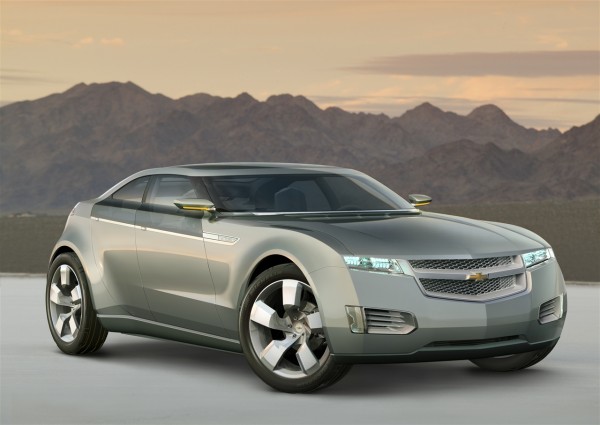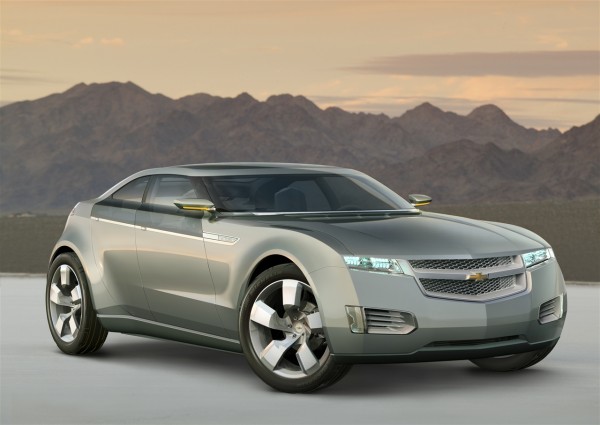 Chevy VoltGM has created a bit of buzz around its claim that the Chevy Volt gets 230 miles to the gallon in city driving. From the internet a great chorus has replied: “This number doesn’t make any sense!” And it doesn’t. The trouble is, it’s not clear what better metric exists for measuring the efficiency of all-electric or plug-in hybrid cars.
Chevy VoltGM has created a bit of buzz around its claim that the Chevy Volt gets 230 miles to the gallon in city driving. From the internet a great chorus has replied: “This number doesn’t make any sense!” And it doesn’t. The trouble is, it’s not clear what better metric exists for measuring the efficiency of all-electric or plug-in hybrid cars.
GM isn’t the only company to make such claims. Tesla has long stated that its electric roadster gets 135 “MPG-equivalent.” Nissan has responded to GM’s claims by announcing that its all-electric Leaf, also slated for sale in 2010, gets the equivalent of 367 MPG.
Where do these numbers come from? For Tesla, the calculation is straightforward, but that doesn’t make it any easier to interpret:
the total energy used for a full charge of the Roadster’s battery is 62.3 kWh (assuming a 15 percent loss). That’s equivalent to 1.85 gallons of gas for the 244 miles that the Roadster can go on a full charge – 244 miles divided by 1.85 gallons gives us a little less than the equivalent of 135 MPG.
This method of calculating “MPG” has the benefit that it’s completely independent of the energy source. You could apply the same calculation to the space shuttle running on liquid oxygen or to a steam engine running on coal. The enormous drawback is that the number is meaningless to car buyers. No one really cares how many kilowatt-hours are needed to move a car around. Rather, people care how many dollars are needed to move a car around, and they might secondarily care how much carbon dioxide is created in the process.
Using some standard figures for the average cost of electricity, the average cost of gasoline, and the average CO2 emissions per kilowatt of electricity, I translated the Tesla electricity usage into miles per gallon based on both cost equivalence and carbon equivalence with gasoline: 89 MPG and 57 MPG, respectively. These are good numbers — well, OK, they’re great numbers, particularly for a high-performance sports car — but they’re not as eye-popping as Tesla’s original claim.
Nissan’s game of one-upmanship is both brash and, by all appearances, totally bogus. The Leaf comes by its reported 367 MPG by way of multiplier of 6.67. This “incentive adjustment” from the Department of Energy is meant to reward auto-makers for producing all-electric vehicles. Whether or not the multiplier makes for good public policy, it surely has no effect on the fuel economy experienced by the car’s owner. Removing the multiplier knocks the Leaf’s rating down to 55 MPG. Whatever that means.
The figure for the Volt is also hard to interpret, but at least GM comes by it honestly. GM claims to have tested the Volt using a “tentative” methodology developed by the EPA. Although the EPA is staying quiet on the matter, many have speculated that the company wouldn’t be bragging quite so loudly if it didn’t have some tacit support from the agency. According to the informed speculation at Edmund’s, GM’s test methodology was to drive 40 miles on an electric charge alone (0 gallons of gas), followed by an additional 11 miles using the internal combustion engine (0.22 gallons of gas). The total of 51 miles on 0.22 gallons of gas yields a mileage of 231 MPG.
Fine. The problem here is that the Volt operates in two dramatically different modes. In the all-electric, limited-range mode, the car uses no gasoline and so gets an effective gas mileage of infinity. Once the battery is drained, the internal combustion engine kicks in and the Volt gets a more conventional 50 miles per gallon. The blended mileage is exquisitely sensitive to the percentage of time spent in each mode. If GM had decided to test drive the Volt for 80 miles rather than 51, the result would have been a rating of about 100 MPG — still great, but a massive step down from the marketing claim. On the other hand, if GM had chosen to drive only 42 miles, the result might have been a fuel economy rating higher than 1,000 MPG.
A four-figure mileage number would have evoked howls of derision, and the Tesla example shows why these howls would be justified. Along the metrics that consumers care about — $/mile or CO2/mile — the inflated figure would be wildly misleading.
So what’s a better metric? Arguably, for all-electric vehicles, we should ditch MPG altogether. Companies can make all the goofy marketing claims they want, but I don’t see much reason for the EPA to get in on the act. Miles per kilowatt-hour will do nicely, along with charging time and miles per charge, to define a vehicle’s performance. Even better, though, would be kilowatt-hours per mile, which scale linearly with the vehicle’s efficiency.
Plug-ins like the Volt, on the other hand, are a tough case. Because they marry two different energy sources (and possibly two different drive trains), the only thing you can really say about their efficiency is, “It depends.” Some have suggested the cars should carry two numbers: the range in all-electric mode, and the average MPG when the combustion engine is running. Using multiple numbers is not terribly consumer-friendly, but then, neither is using a single number that doesn’t mean anything.
Finally, as Hank at ecogeek reminds us, whatever method we use to measure the performance of electrics and hybrid electrics, these are all very fuel-efficient cars.




